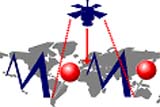
-
StatusCompleted
-
Status date2014-12-09
The MoMoSat approach aims at an innovative service, that supports the secure collaboration of mobile individuals in the field by a map-based information system on wireless PDA (Personal Digital Assistant) devices.
The service uses up-to-date high quality satellite images and maps, displayed on the screen of the mobile device (notebook or tablet-pc), as a pin board on which information (i.e. text or voice notes, measurements, photos, or videos) can be pinned down interactively by the users on site. These so called 'Geonotes' can be used for collaborative communication with other users nearby as well as for documentation purposes, by uploading them to the home location via a satellite connection. The overall service is protected by a scalable security scheme that includes encryption and digital signatures.
To summarize, MoMoSat offers an extended map-based news group service. It offers new means for dependable and secure collaboration in the field.
Three key issues have been addressed:
- Current software systems for team collaboration are based on file structures. In MoMoSat, we developed a map based collaboration system that organizes notes according to their geographic association.
- Current interactive mapping tools typically require powerful client soft- and hardware. One result of MoMoSat is, that the software can be used on mobile devices such as notebook and tablet-PC, but PDA devices do not have sufficient resources at the moment.
- MoMoSat will process high volumes of multi-media content. These data volumes must be efficiently en- and decrypted for mobile devices.
MoMoSat will develop the prototype of a location-based SatCom service, where mobile ("nomadic") end-users in the field can securely view, manage, annotate, and communicate any kind of geo-referenced information in real-time. Based on broadband satellite connection, MoMoSat enables mobile users to work with their mobile computing devices just as they are used to work at their home office. They can equally well retrieve up-to-date information from their office, or actively upload new data to the office. In addition, this service is independent of terrestrial infrastructure, which renders this service highly relevant for relief organisations.
MoMoSat has a J2EE (Java 2 Enterprise Edition) multi tier architecture using interfaces and protocols as defined by the OpenGIS consortium. The programming language of choice was Java. Mobile client may be any computers supporting J2SE (Java 2 Standard Edition). Servers and routers will be standard PC running Linux.
Software components:
- J2SE mapping client
- standard OGC MapServer
- Geonote management system (GeoServer)
Security:
- IPSec (IP Security) for communication security
Satellite Comunication:
- VSAT
- Eutelsat SESAT 36E T G6
- Central hub: FDMA based DAMA system, DVB-S, 8 Mbps forward channel IPv4/DVB encapsulator - Multi Protocol Encapsulation (MPE)
- Remote gateway: 64 -384 return link, bandwidth allocation on demand DVB receiver card (DVB-S), FDMA QPSK SCPC modem for return channel
Local Area Network:
- Wireless LAN: IEEE 802.11 a/b, ad hoc mode
Voice over IP Communication:
- FOKUS SIP Express Router
- SjPhone VoIP client
The MoMoSat project started in January 2003. It went through the 4 phases until July 2004:
I. Phase: User Requirements Analysis (January '03 - March '03)
In February a document, describing the main features of the overall MoMoSat service was used as a base for discussing the individual user requirements during workshops with the potential users. The results of phase I. are outlined in the two documents: 'user requirements', and 'demonstrator definition' (BDR).
II. Phase: System Development (April '03 - August '03)
The implementation of the MoMoSat prototype, including Spatial Information Management, WLAN and SatCom, and security services was based on the preceding definition of architectural design and technical requirements (MTR).
III. Phase: Validation of Prototype (September '03 - April '04)
Beside internal validation of the systems components, the MoMoSat demonstrator was validated by the user groups against the demonstrator definition document.
IV. Phase: Commercial Feasibility Study (October '03 - June '04)
A feasibility study about the commercialisation of the MoMoSat service was developed and transferred into a roadmap to market.
The MoMoSat project was completed successfully in July 2004.
The following results have been achieved:
- A system architecture was developed as a four-level hierarchy of modules that are "loosely coupled". Substitution of a module at any level is possible without affecting the overall system's proper working, if the substitute satisfies all the defined technical requirements for the replaced module.
- A demonstrator system was built up, which supports all of the generic user requirements. The demonstrator was tested successfully by the users.
- Even though there are technical and legal restrictions in some areas of the world for using satellite communication (SatCom), it has been turned out that SatCom is an important infrastructure especially in countries with poor communication infrastructure or even in industrialised countries in case of catastrophes (e.g. flood or earthquake).
- VoIP communication has been realised by WLAN (in the field) and SatCom (between field and office) technology.
- A platform independent GIS client was developed, which allows the remote access to OGC mapservers as well as the upload and shared use of location based informations via WLAN and SatCom connectivity.
- The market analysis performed promises business opportunities especially with large internationaly acting organisations. We identified no mass market, but an interesting niche market for small and medium enterprises is expected to be developed within the near future.
The final presentation of the project results was given at the "ESA Telecom Start-up Projects Workshop 1", 23rd of March 2004 at ESTEC: http://telecom.esa.int/startupworkshop1
The final review (FR) of the overall project was done at the 1st of July 2004 at ESTEC.




